|
Repotting Houseplants
|
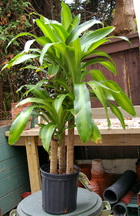
When and Why?
In an indoor location where plants receive a similar light regime on a year round basis, then potting houseplants should be done when they are too big for the existing pot. Either it actually falls over or it has to be watered too often because the small amount of soil cannot hold a sufficient water supply.
If the plant is used to a natural light cycle, then, while the above two situations still apply, it is best to repot in the late winter/early spring when the increased light levels will start to initiate new growth.
Where?
It usually better to undertake repotting houseplants as close to the plant’s usual location, as possible. The little bit of cleanup is a much smaller problem than the destruction created trying to carry a large plant through the house. Just lift the plant and pot up and slip a drop cloth underneath it and you are ready to go.
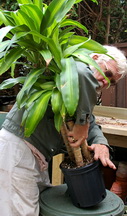 How?
How?
The process is easier if you realize that your first step is to remove the pot from the soil ball. Now that may sound obvious but what I’m trying to say is a bit of a subtle concept; removing the pot from the soil ball is much easier and less damaging, than trying to remove the plant from the pot. When the soil is moist, about halfway through your watering cycle, gently hold the whole plant and lift it. Now tap around the edge of the pot’s rim and it should fall away from the soil ball. This may take two people depending on the size of the plant. If it will not let go, make the soil a bit wetter and try again. As a last resort, when repotting houseplants, cutting or breaking the old pot is far preferable to pulling on the plant and damaging its roots.
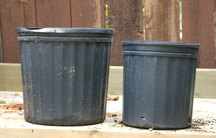
The New Pot?
Do not move to a much larger pot in an attempt to avoid doing this again for several years. A new pot should only be one or two sizes larger than the old pot. There would ideally be no more than 5 cm (2") of space between the soil ball and the edge of the new pot. Since that is all around, the plant actually gets as much as 10 cm of new soil to grow into. A new pot of that size will probably be noticeably deeper than the old pot. Try to avoid repotting houseplants into a shallower pot.
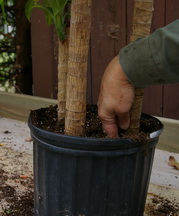 How Deep?
How Deep?
Constant watering has worn down the top of the soil ball. Place enough soil in the bottom of the new pot to allow for 2 - 4 cm of new soil on top of the old soil ball. There should still be about 2 - 3 cm of pot rim above the soil to allow for easy watering. Pack new soil between the sides of the new pot and old soil ball. It needs to be firm enough to eliminate any air pockets and to hold the plant firmly in place. The new roots do have to grow through it, so resist the urge to turn it into concrete.
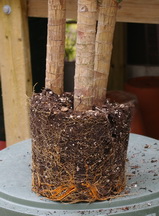
Details!
If the roots at the bottom of the old soil ball are a solid mass, then cutting through them in a few spots and even removing some, will encourage the plant to grow new roots into the new soil. When the job is finished water the plant well with a starter fertilizer solution such as 10 52 10 to encourage new root growth. This repotting is also an obvious time to straighten plants that have developed a permanent lean.
Watering?
Remember to adjust your watering cycle. For the first few weeks you may need to water while the new soil is still damp because all of the roots are still in the old smaller and drier soil ball. Gradually lengthen the time between waterings to encourage the roots to grow into the new soil to find water.
Clean up the bit of soil that missed the new pot. You’re done! The plant looks better and feels happier and is ready to reward you for your efforts.
Get answers to your gardening questions by subscribing to
Ken’s free newsletter, Dallying In The Dirt
return from repotting houseplants to Houseplants main page
